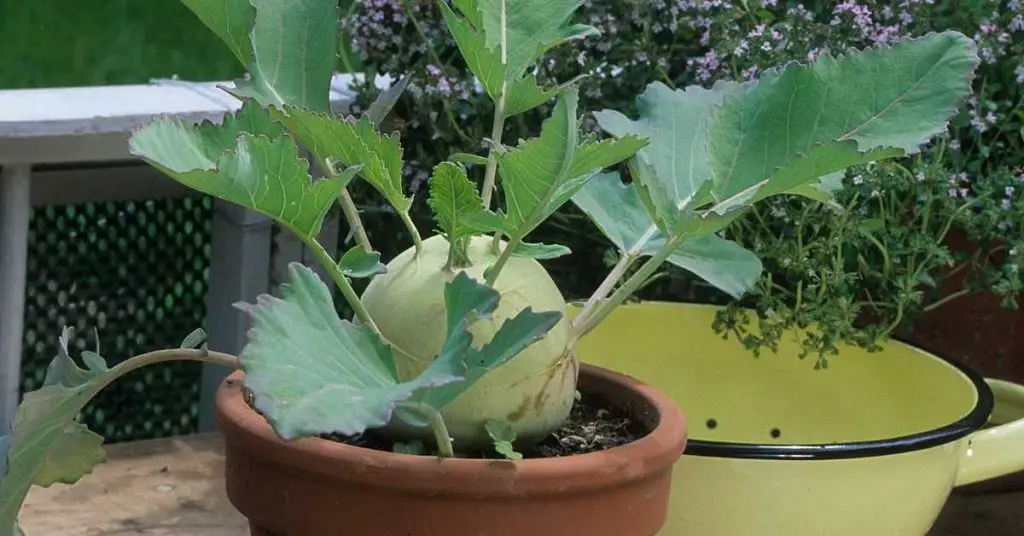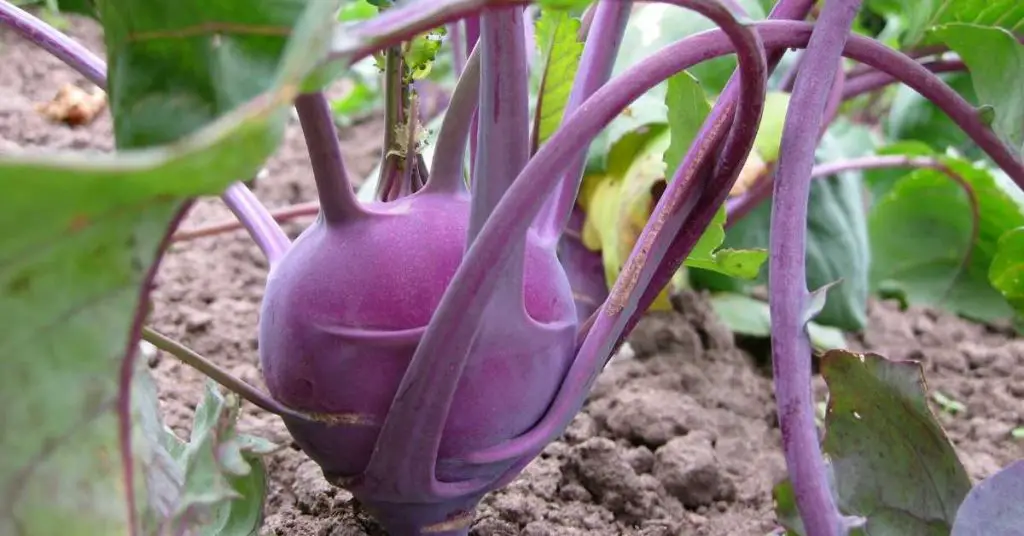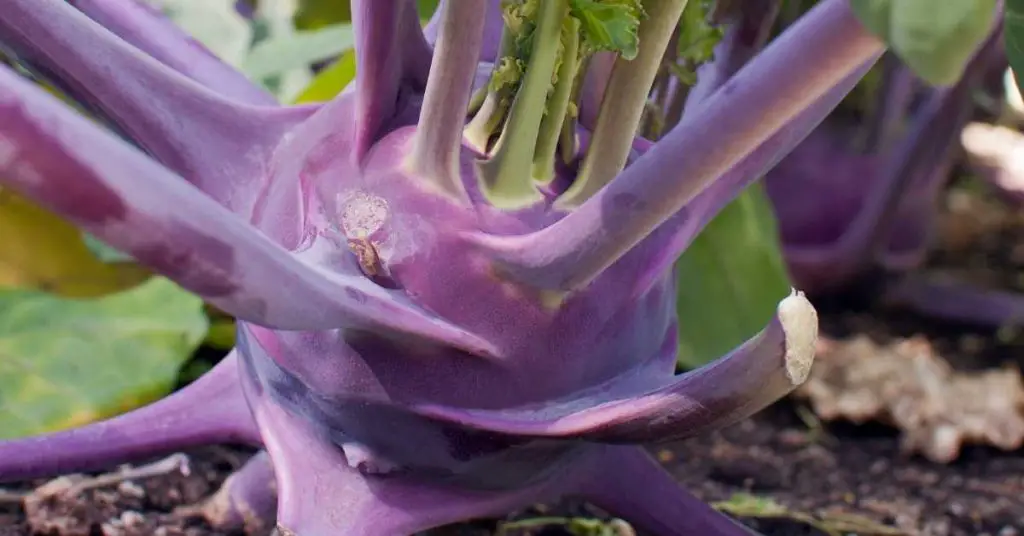How to Grow Kohlrabi in Containers: Things You Need To Know
You can grow Kohlrabi in containers by planting seed directly into your pot filled with nutrient-dense potting mix or by starting seeds 4-6 weeks before your last frost to transplant outside when it is safe. Once you have planted your seeds or your plants you just need to make sure to keep them watered, give them a bit of water-soluble fertilizer such as compost tea or fish emulsion every 10 days until they are ready to harvest.
Growing kohlrabi in containers is a great way to grow vegetables in small spaces. They are easy to grow and maintain, and they have many delicious uses! In this post, we will look at how to grow Kohlrabi in containers, from how long it takes to reach maturity, how often you should water them, when the best time of year is for growing them outside or inside, how much sun they need, and more.
What is Kohlrabi?
Kohlrabi is a member of the Brassica family that is grown during the cool months of fall, early winter, and early spring just like the other member so the Brassica family like broccoli, cabbage, and cauliflower. Kohlrabi is grown primarily for its edible bulb-shaped stem but it also has edible leaves that go great in stir-fries and other dishes.

Is Kohlrabi Easy to Grow?
Yes, Kohlrabi is easy to grow given the right conditions and the proper care. It can be grown in the ground, raised beds, and containers with minimal effort. Kohlrabi matures in just about 6-8 weeks. Unlike its other Brassica family members, Kohlrabi is relatively pest-free so you shouldn’t have to worry about trying to protect it during the growing season.
How many Kohlrabi Do You Get Per Plant?
Kohlrabi will produce one bulb per plant that you grow in addition to the edible leaves. There have been some cases where people have noticed a Kohlrabi plant that produced multiple bulbs on one stem or plant. This is incredibly rare and shouldn’t be expected.
If you get a Kohlrabi plant that produces more than one bulb then you should try saving seed from that plant to grow again the following year. You may end up with a different variety that grows more than one bulb and you could be able to normalize that into a plant that will consistently produce more than one bulb.
When Should you Plant Kohlrabi?
Kohlrabi can be planted in Spring or Fall in the north and just in the fall for a winter harvest anywhere in the south. You can start this vegetable inside or directly outside at either time of the year but it is almost always better for you to start Kohlrabi seeds indoors for a Spring planting. You can sow them outdoors during midsummer for a fall crop.
Related: Starting Seeds Indoors.
Can you Transplant Kohlrabi?
Yes, you can transplant Kohlrabi that you have started either indoors under lights or Kohlrabi plants that you have started outdoors. Kohlrabi is a fairly resilient plant that is easy to transplant into your garden.
How to Transplant Kohlrabi Seedlings
Just loosen the root ball from the seedling pot, put your fingers around the base of the plant, turn the seedling pot over, and gently slide the seedling with as much of the root ball out into your hand. Then plant into the planting hole in your bed or container.
Backfill soil around your newly planted Kohlrabi and press down slightly to firm up the soil around the base of the plant. Give your new plants a good watering and keep the soil moist around the plants over the course of the next few days to help the plant take hold.
Can you Start Kohlrabi Indoors?
Yes, you can start Kohlrabi seeds indoors 4-6 weeks before your last frost underneath a good light. Make sure to keep them close to the lights so that they can grow big and strong. You can then transplant them outdoors after the last danger of frost has passed.
This light can be either a basic fluorescent shop light or LED grow light depending on how many plants you are trying to start or how much you are wanting to spend.
Do Kohlrabi Seeds Need Light to Germinate?
No, Kohlrabi seeds do not need light to germinate. They do need warmth and moisture like many other types of seeds to germinate. Just plant them in seedling containers filled with good quality seed starting mix, water them in and place them in a tray on top of a heat mat.
The seed starting mix or a good quality potting mix will help your seeds to sprout faster and give them a loose mix to grow a good root system. The heat mat will give them the warmth they need to germinate and then you can get them under a good source of light to prevent legginess.
Can you Direct Sow Kohlrabi?
Yes, you can direct sow Kohlrabi seeds in-ground, raised beds, and in containers with no issues. Kohlrabi can be sown outside after your last frost or up to 2 weeks before your last frost if you are using row covers. If you are wanting to plant Kohlrabi in the fall, count back 90 days from your first frost to determine when to sow your seeds. This will make sure that you have enough time for your Kohlrabi to sprout and grow to maturity before frost hits.
Related: How to Use Row Covers to Extend Your Season
Does Kohlrabi Need Full Sun?
Yes, Kohlrabi prefers a location in your garden that has rich, well-draining soil that gets at least 6 hours of full sun to really do its best.
How Big do Kohlrabi Plants Get?
The average Kohlrabi plant can grow up to about 16-18 inches tall and can be roughly 16 inches wide. The leaves can get fairly large and the bulb can reach up to 6 inches in diameter for some of the larger varieties. There are some smaller, more dwarf varieties that will stay on the smaller side that will work in close or cramped gardens.
Even though Kohlrabi plants can get fairly large they can still be grown pretty close together considering. I have personally grown them 2 per square foot with minimal issues.

How Much Space Does a Kohlrabi Plant Need?
Kohlrabi should be planted in rows approximately 10-16 apart so that they can spread out a little and get some size to them. Kohlrabi can be grown using the square foot gardening method as well with about 2 plants per square foot of your plant area.
You can use this same idea when it comes to planting Kohlrabi in containers. Just make sure that you use a pot that is large enough to provide the correct amount of space for each plant.
What is the best size container for Kohlrabi?
The best size container for Kohlrabi is a pot that is large enough to hold the number of plants that you want to put in it. If you are just growing one Kohlrabi plant then you will need a pot that is at least 14-16″ in diameter and equally as deep so that the Kohlrabi roots can grow down.
If you are wanting to grow multiple plants in one pot or container, just try to follow the square foot gardening recommendation of a container that will give each plant enough room. You should also fill the container with a high-quality, nutrient-dense potting mix with a ton of organic matter in it to support the multiple plants.
How deep do kohlrabi roots grow?
Kohlrabi has roots that generally grow between 12-18″ deep. You can plant them in an open bottom raised bed that is just 6″ deep and the roots will grow through into the native soil or you can provide them with a raised bed that is 18″ deep to give them enough room.
You should make sure that when you are choosing a container that you choose one that is deep enough for the roots to grow a good system. I recommend a pot or container that is at least 16″ deep. This should give your Kohlrabi roots plenty of space to fill out the pot.
How long does it take to grow kohlrabi?
Kohlrabi is a fast-growing vegetable that generally takes between 50-70 days from transplant to fully mature or roughly 90 days from seed to harvest depending on the variety. In this case, you can usually get a couple of harvests a year if you live in an area where you can plant Kohlrabi in the Spring and Fall.
If you do not live in a zone where you plant in each of those seasons you can sometimes plant multiple plantings using succession planting so that you can stagger your harvest over the course of a few weeks.
How do you know when kohlrabi is ready to be picked?
Kohlrabi is ready to be picked when the bulb on the stem reaches anywhere between 1 and 3 inches in overall diameter. You can harvest it really at any point but you want to get a bulb that is comparable to a baseball or slightly bigger.
If you wait too long the bulb and stem can become woody or tough to eat especially in warm weather.

Will kohlrabi grow back after harvesting?
Yes and no. Kohlrabi is a biennial plant that will generally produce one bulb on its stem per plant over the course of the first season. The Kohlrabi plant during its second season if left in the ground will put on more leaf growth and eventually produce a flower stalk to produce seeds. Your Kohlrabi plant will not produce a second bulb in the second year.
Frequently Asked Questions (FAQs)
Here are some of the most asked questions:
Why are my kohlrabi not forming bulbs?
If your Kohlrabi is not forming a bulb on its stem it could be planted too closely with another Kohlrabi plant or other vegetation, it might not be the correct season, or there could be too a nutrient deficiency in your soil.
Can you eat all of the Kohlrabi?
Yes, the entire Kohlrabi plant is edible. The bulb, stem, leaves, and flowers are all edible and quite delicious. Kohlrabi is a part of the Brassica family so much like its cousins the cabbage and kale plants, you can enjoy the entire plant.
What can I do with Kohlrabi leaves?
Kohlrabi leaves are often one of the most overlooked parts of the plant and can be used in a variety of different ways. You can chop them up and put them into a mixed salad with other greens and lettuce. They are delicious when you cook them down like you would with spinach or chard with some olive oil, shallots, fresh garlic.
Related: 9 Salad Greens Everyone Should Grow
What can you not plant next to Kohlrabi?
When it comes to planting Kohlrabi you should avoid planting it next to peppers, pole beans, strawberries, and tomatoes. These are not good companions and can affect how your Kohlrabi plants grow.
You should plant Kohlrabi with beets, other Brassicas, cucumbers, and onions as these are good choices for companion plants.
Is Kohlrabi a heavy feeder?
No, Kohlrabi is not a heavy feeder. It will be just fine if you start off with a pot filled with a good high-quality potting mix that has had compost added to it. You can supplement with some worm castings if you feel like your plants need a little something extra.
Does Kohlrabi need fertilizer?
Kohlrabi needs to be planted in a pot filled with a high-quality potting mix that has been amended with things like compost, organic granular fertilizer, and worm castings. These will provide with a good start to its growing season and enough food until it is ready to be harvested.
If you are planting it and cannot add these things to the soil before planting you should top or side-dress with 2 inches of compost or worm castings. You can also water your container Kohlrabi once every 7-10 days with a half-strength liquid fertilizer, compost tea, or fish emulsion to give it that little extra it needs to grow to a good size in a container.
How do you fertilize Kohlrabi?
Fertilize with a balanced fertilizer liquid fertilizer. The best time to feed the plant is when they are 3-4 inches in height, about a month after sowing seed. Add blood meal, cottonseed meal, or composted manure to the soil before planting for enrichment.
In Conclusion
We hope this article has given you the information and motivation to grow your own kohlrabi. It is easy, fun, and tasty!
Let us know how it goes in the comments below or if you have any questions about what we discussed here. Happy gardening!






